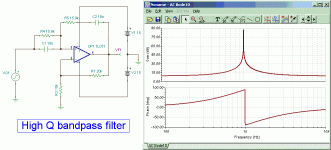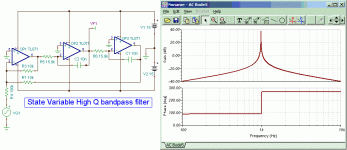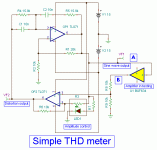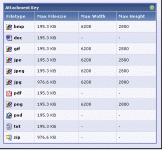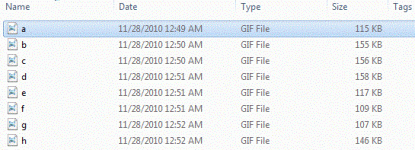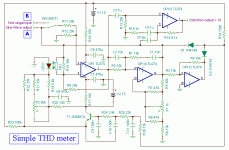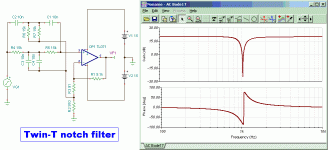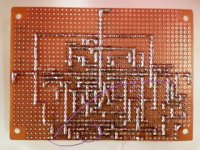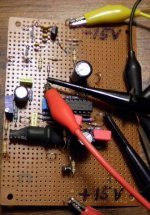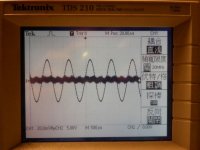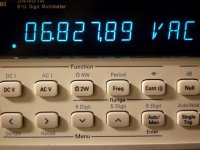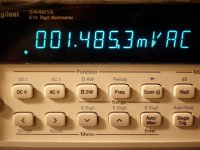Amateur audiophiles who build amplifiers by themself always have a demand for measuring the distortion of their amplifiers.
A distortion meter for amateur audiophiles is very necessary.
But a professional distortion meter is very expensive.
A poor amateur audiophile like me cannot afford it.
So I intended to build a distortion meter by myself for more than twenty years ago.
When I studied about distortion meters.
I found a THD (total harmonic distortion) meter is usually composed of two parts.
The first part is a low distortion Sine-Wave oscillator.
The second part is a High-Q notch filter.
If I want to distinguish 0.01% distortion,
The distortion of the low distortion Sine-Wave oscillator have to be lower than 0.01%.
That means the distortion have to be lower than -80 dB.
To build a Sine-Wave oscillator with the distortion lower than -80 dB is not difficult.
The real difficulty is to match the frequencies of the Sine-Wave oscillator and the notch filter.
Because of the affection of the environment,
The frequencies of the Sine-Wave oscillator and the notch filter keep drifting all the time.
It is very difficult to match the frequencies of the Sine-Wave oscillator and the notch filter.
So a THD meter usually has very complicated circuits of the filter to trace the frequency and phase of the Sine-Wave oscillator.
Many years ago,
An idea occured to me.
I found a low distortion Sine-Wave oscillator is also a High-Q bandpass filter itself.
Hence a low distortion Sine-Wave oscillator can distinguish distortion by itself!
There's no need to trace the frequency and phase at all.
It's a very simple idea,
But I wonder why this idea hasn't been used commonly.
I told Mr. Pass this idea.
Mr. Pass encouraged me to achieve this idea.
He said it will be a great DIY project.
So I do this project at my idle time (usually at Sunday afternoon).
These two figures show two kinds of High-Q bandpass filters.
Wien Bridge and State variable filter are the most common circuits of low distortion Sine-Wave oscillators.
A distortion meter for amateur audiophiles is very necessary.
But a professional distortion meter is very expensive.
A poor amateur audiophile like me cannot afford it.
So I intended to build a distortion meter by myself for more than twenty years ago.
When I studied about distortion meters.
I found a THD (total harmonic distortion) meter is usually composed of two parts.
The first part is a low distortion Sine-Wave oscillator.
The second part is a High-Q notch filter.
If I want to distinguish 0.01% distortion,
The distortion of the low distortion Sine-Wave oscillator have to be lower than 0.01%.
That means the distortion have to be lower than -80 dB.
To build a Sine-Wave oscillator with the distortion lower than -80 dB is not difficult.
The real difficulty is to match the frequencies of the Sine-Wave oscillator and the notch filter.
Because of the affection of the environment,
The frequencies of the Sine-Wave oscillator and the notch filter keep drifting all the time.
It is very difficult to match the frequencies of the Sine-Wave oscillator and the notch filter.
So a THD meter usually has very complicated circuits of the filter to trace the frequency and phase of the Sine-Wave oscillator.
Many years ago,
An idea occured to me.
I found a low distortion Sine-Wave oscillator is also a High-Q bandpass filter itself.
Hence a low distortion Sine-Wave oscillator can distinguish distortion by itself!
There's no need to trace the frequency and phase at all.
It's a very simple idea,
But I wonder why this idea hasn't been used commonly.
I told Mr. Pass this idea.
Mr. Pass encouraged me to achieve this idea.
He said it will be a great DIY project.
So I do this project at my idle time (usually at Sunday afternoon).
These two figures show two kinds of High-Q bandpass filters.
Wien Bridge and State variable filter are the most common circuits of low distortion Sine-Wave oscillators.
Attachments
I choose Wien Bridge as the first trial.
Because Wien Bridge is simpler.
Here is the simplified circuit of the simple THD meter.
This cricuit can work but its distortion character not good enough.
The voltage gain between point A and point B in this schematic have to be equal to 1 (0 dB).
In practical testing procedure,
It still need an Attenuator and an amplifier to adjust the voltage gain.
The key component of this circuit is the photo-coupler.
I use 5mm Red LED and CDS (Cadmium-Sulfide) photo resistor covered by Heat-shrink tube to make a photo-coupler.
Because Wien Bridge is simpler.
Here is the simplified circuit of the simple THD meter.
This cricuit can work but its distortion character not good enough.
The voltage gain between point A and point B in this schematic have to be equal to 1 (0 dB).
In practical testing procedure,
It still need an Attenuator and an amplifier to adjust the voltage gain.
The key component of this circuit is the photo-coupler.
I use 5mm Red LED and CDS (Cadmium-Sulfide) photo resistor covered by Heat-shrink tube to make a photo-coupler.
Attachments
It's all fine on my browser.
So this one I cannot help you.
But you should be able to download Cordell's article.
Patrick
So this one I cannot help you.
But you should be able to download Cordell's article.
Patrick
Sorry!
I have problem to upload pictures.
I don't know why?
write type and size of file you tried to upload , so we can see what's culprit
Attachments
More than twenty years ago,
The first THD meter circuit I studied is this one.
write type and size of file you tried to upload , so we can see what's culprit
It seems I cannot upload a file bigger than 30KB.
Attachments
At first,
The distortion character of my simple THD meter could only reach about -50 dB to -60 dB.
So I spent a long time to tune this circuit, reduce its distortion to about -93 dB.
Although the Sine-Wave amplitude and the distortion signal keep drifting a little bit.
But the distortion character still way beyond -80 dB anyway.
Here are schematic and pictures of the simple THD meter prototype, Sine-Wave and distortion waveforms, Sine-Wave and distortion output voltages.
Because of the variety of LED and CDS,
Just follow my schematic to build it may not succeed.
It needs some tuning to get a steady oscillation.
And it still has much room for improvement.
I will keep improving it when I have idle time.
Next step,
I will try to change the x10 amplifier of the distortion output into a Twin-T notch filter.
PS. Sorry! I cannot upload my prototype's pictures.
The distortion character of my simple THD meter could only reach about -50 dB to -60 dB.
So I spent a long time to tune this circuit, reduce its distortion to about -93 dB.
Although the Sine-Wave amplitude and the distortion signal keep drifting a little bit.
But the distortion character still way beyond -80 dB anyway.
Here are schematic and pictures of the simple THD meter prototype, Sine-Wave and distortion waveforms, Sine-Wave and distortion output voltages.
Because of the variety of LED and CDS,
Just follow my schematic to build it may not succeed.
It needs some tuning to get a steady oscillation.
And it still has much room for improvement.
I will keep improving it when I have idle time.
Next step,
I will try to change the x10 amplifier of the distortion output into a Twin-T notch filter.
PS. Sorry! I cannot upload my prototype's pictures.
Attachments
wensan - send me those pics at >choky@neobee.net< and I'll upload them
Thanks!
I come to my father's house and upload those pictures successfully.
Nicely done PCBs.
😉
Patrick
Thanks!
You see its's very simple and cheap.
That is the most important thing of this project.
What surprise Wensan!
Would be a dream for me, fine tuning the amps like Nelson descriped....
Every DIYer shuld fine tuning the amps like Nelson descriped.
- Status
- Not open for further replies.
- Home
- Amplifiers
- Pass Labs
- Simple THD meter
